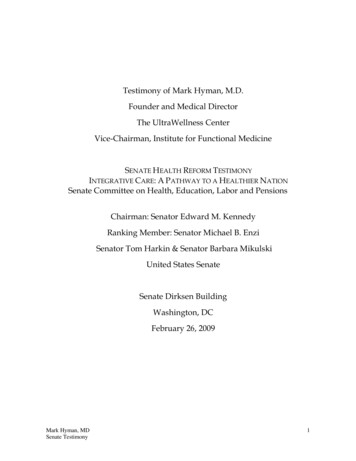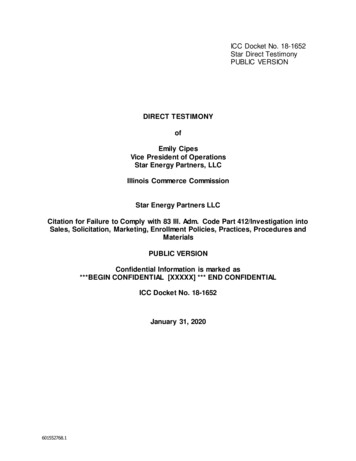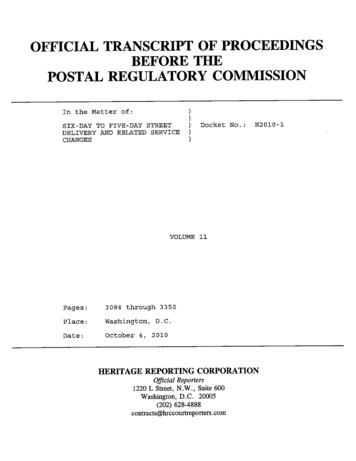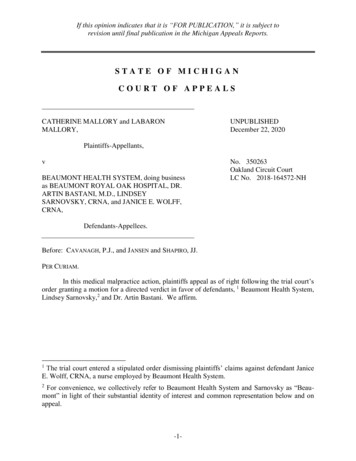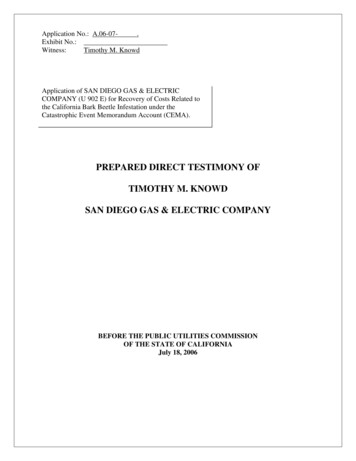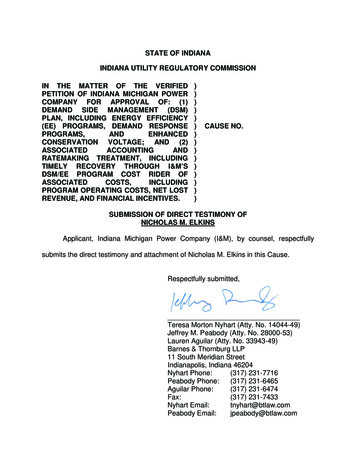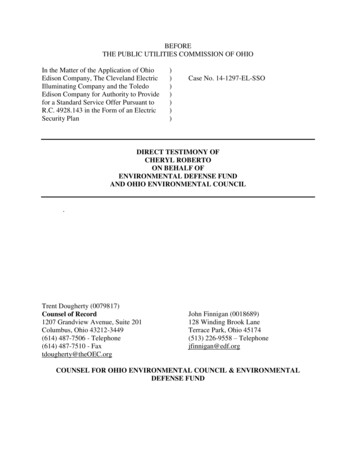
Transcription
BEFORETHE PUBLIC UTILITIES COMMISSION OF OHIOIn the Matter of the Application of OhioEdison Company, The Cleveland ElectricIlluminating Company and the ToledoEdison Company for Authority to Providefor a Standard Service Offer Pursuant toR.C. 4928.143 in the Form of an ElectricSecurity Plan)))))))Case No. 14-1297-EL-SSODIRECT TESTIMONY OFCHERYL ROBERTOON BEHALF OFENVIRONMENTAL DEFENSE FUNDAND OHIO ENVIRONMENTAL COUNCIL.Trent Dougherty (0079817)Counsel of Record1207 Grandview Avenue, Suite 201Columbus, Ohio 43212-3449(614) 487-7506 - Telephone(614) 487-7510 - Faxtdougherty@theOEC.orgJohn Finnigan (0018689)128 Winding Brook LaneTerrace Park, Ohio 45174(513) 226-9558 – Telephonejfinnigan@edf.orgCOUNSEL FOR OHIO ENVIRONMENTAL COUNCIL & ENVIRONMENTALDEFENSE FUND
1I.INTRODUCTION2Q.PLEASE STATE YOUR NAME AND BUSINESS ADDRESS.3A.My name is Cheryl Roberto. My business address in 1207 Grandview Ave., Suite 201,45Columbus, OH 43212.Q.67TITLE?A.89I am employed by Environmental Defense Fund (“EDF”) as Associate Vice President,EDF Clean Energy Program.Q.1011BY WHOM ARE YOU CURRENTLY EMPLOYED, AND WHAT IS YOUR JOBPLEASE BRIEFLY DESCRIBE YOUR EDUCATIONAL BACKGROUND ANDYOUR RELEVANT PROFESSIONAL EXPERIENCE.A.I earned a B.A. in Political Science from Kent State University, a J.D. from the Ohio12State University Moritz College of Law. In my current position at EDF, I lead the13national EDF Clean Energy Program. Through regulatory reform and new utility14incentives, among other approaches, the EDF Clean Energy Program aims to help15modernize our outdated energy infrastructure, accelerate the deployment of cutting-edge,16clean technologies into the nation' electric system and break down the regulatory and17financial barriers to broad-scale adoption of renewable energy, energy efficiency and18other innovative ways to generate, distribute and use energy. Prior to joining EDF, I19served as a Commissioner of the Public Utilities Commission of Ohio (PUCO) from 200820to 2012, where I was the lead commissioner for PUCO's partnership with the United21States Department of Energy combined heat and power pilot project. As a member of the22National Association of Regulatory Utility Commissioners (NARUC), I served as Co-23Chair of the 2012 National Electricity Forum, which centered on envisioning an1
1intelligent, interactive and resilient electric grid. I also served as a member of the2NARUC Task Force on Environmental Regulation and Generation, the Committee on3Electricity, as Vice-Chair of the Committee on Critical Infrastructure, and on the board of4the National Regulatory Research Institute. During my tenure on the Ohio Commission,5I participated in all three prior Electric Security Plan (ESP) cases (12-1230-EL-SSO, 10-6388-EL-SSO, and 08-935-EL-SSO) for Ohio Edison Company, The Cleveland Electric7Illuminating Company and The Toledo Edison Company (“the Companies”). Prior to8joining the Ohio Commission, I served as Director of Public Utilities for the City of9Columbus, Ohio. In that capacity, I led a municipal water, wastewater, and electric10utility with combined annual operating budget of 400 million dollars, an annual capital11budget of 250 million dollars, and a staff of 1300 people serving 15th largest City and1222 Central Ohio political subdivisions. In this role, I oversaw cost of service rate updates13for three of the utilities. For the electric distribution utility I structured and negotiated a14staggered, load-following power procurement agreement that included pre-existing15bilateral contracts and limited owned generation.16Q.ON WHOSE BEHALF ARE YOU TESTIFYING?17A.I am testifying on behalf of EDF and the Ohio Environmental Council (“OEC”),1819intervenors in this case.Q.2021HAVE YOU SUBMITTED TESTIMONY IN ANY PREVIOUS CASES BEFORETHE COMMISSION?A.I have previously testified in PUCO Case No. 13-2385-EL-SSO concerning the Ohio22Power Company’s plan to eliminate Time of Use Tariffs; (ii) review the Company’s23gridSmart Phase 2 Rider; and (iii) review the Company’s Economic Development Rider.2
1WHAT IS THE PURPOSE OF YOUR TESTIMONY?2A.The purpose of my testimony is to review what the Companies have labeled as the3Economic Stability Program, but which is more aptly described as a Non-Competitive4Purchase Agreement, within their fourth proposed ESP.5678II.Q.ARE YOU FAMILIAR WITH THE COMPANIES’ PROPOSED ECONOMICSTABILITY PROGRAM, OR AS YOU HAVE REFERRED TO IT, THE “NON-9COMPETITIVE PURCHASE AGREEMENT”?1011OVERVIEW OF “NON-COMPETITIVE PURCHASE AGREEMENT”AND OUTLINE OF TESTIMONYA.Yes. The Companies propose to enter into a 15-year commitment to purchase the output12from power plants owned by its sister company (“Non-Competitive Purchase Agreement”13or “Agreement”) FirstEnergy Solutions (“FES”). The Non-Competitive Purchase will be14secured or guaranteed by payments made by their customers under a new fee or tariff15which they propose to call a “Retail Rate Stabilization Rider” or Rider RRS. Under the16Non-Competitive Purchase Agreement, FES would transfer to the Companies the right to17sell all output, including energy, capacity and ancillaries, from the FES share of the Ohio18Valley Electric Corporation (“OVEC”) which includes two sixty-year old, coal-fired19power plants (Kyger Creek in Cheshire, Ohio and Clifty Creek in Madison, Indiana) , the20fifty-two year old, Sammis coal-fired plant and the Davis-Bessie nuclear plant which is21two years from the expiration of its forty-year license. The Companies, pursuant to the22guarantee of their customers, would pay their sister company, FES, for the plants’23operation and upkeep including but not limited to fuel and environmental compliance24obligations and a profit. The customers would assume all risk that the plants will remain3
1operational. In the case of the Davis-Besse plant, the customers will also assume the risk2that the plant will be re-licensed.3The Companies would sell the plants’ output into the PJM markets. The4Companies would collect from its customers through Rider RRS the difference between5the plants’ costs (including profits for its sister company) and whatever revenues may be6earned in the PJM markets. While the Companies acknowledge that for at least the first7years, its customers will be required to subsidize the operation of its sister company’s8plants, Companies claim that this proposal has a net present value of 800 million for9customers over the fifteen year life of the Non-Competitive Purchase Agreement. The10Companies stated purpose in proposing this Agreement is to provide electric reliability11and price stability to customers.12Q.PLEASE EXPLAIN HOW YOUR TESTIMONY IS ORGANIZED.13A.I have presented my testimony in two sections. First, I explain my recommendation as to14why the Commission should reject the Non-Competitive Purchase Agreement Non-15Competitive Purchase Agreement. Next, I present recommendations which the16Commission should impose on the Companies if the Commission is inclined to approve17the Agreement.1819202122III.THE COMMISSION SHOULD REJECT THENON-COMPETITIVE PURCHASE AGREEMENTNON-COMPETITIVE PURCHASEAGREEMENTQ.232425WHAT IS YOUR INITIAL RECOMMENDATION REGARDING THE NONCOMPETITIVE PURCHASE AGREEMENT?A.I recommend that the Commission should reject the Non-Competitive PurchaseAgreement because the Agreement is not necessary to achieve the stated goal of4
1reliability and it: (1) would harm the market by subsidizing the Companies’ uneconomic2generation for the near term; (2) would lock the Companies into a risky long-term supply3contract; (3) would distort the competitive market; (4) was not developed through an4integrated resource process or request for proposal or the Companies’ long-term forecast;5(5) did not include an evaluation of other types of generation resources, or cost-effective6energy efficiency or demand response resources; (6) interferes with wholesale energy and7capacity markets; (7) is based on the faulty premise that the Companies are responsible8for the reliability of generation and transmission service; (8) could make it more costly9for Ohio to comply with the EPA’s Clean Power Plan; (9) could provide a windfall for10FirstEnergy and the Companies by allowing them to, in effect, receive an improper11double recovery of transition costs; (10) involves inconsistent energy and capacity price12forecasts than what the Companies have previously submitted to the Commission; and13(11) involves an inherent, and unacceptable, conflict of interest among Companies and14their affiliates.15Q.1617HOW WOULD RELIABILY BE ACHIEVED IN THE ABSENCE OF THIS NONCOMPETITIVE PURCHASE AGREEMENTE?A.Mr. Moul testified that the plants’ economic vitality is in doubt because market-based18revenues for energy and capacity have been at historic lows and do not cover the costs of19making the necessary investments and operating the plants. He testified that this will20continue to be the case for the near-term future. As a result, the plants could be retired21causing reliability concerns. However, if, in fact, a plant’s deactivation would cause22reliability concerns, PJM’s Open Access Transmission Tariff at Part V - Generation23Deactivation provides an avenue for the plant to receive cost of service compensation.5
1The plant could voluntarily continue operating under a “must run” contract and be2compensated in a manner similar to that proposed in the Non-Competitive Agreement.3Any costs incurred to provide adequate compensation to the generation owner who would4otherwise deactivate a plant would be allocated as an additional transmission charge to5those within the area where reliability would be impacted. In other words, there is no6reliability reason whatsoever for the Companies to enter any commitment and certainly7not a fifteen year commitment to purchase the output from its sister company’s plants. If8these plants ever become uneconomic to run and their deactivation causes a reliability9concern, PJM will offer FES a cost-based contract to continue operating – exactly the10remedy proposed but without the fifteen year commitment to a Non-Competitive11Purchase Agreement.12Q.SUBSIDIZE THE COMPANIES’ UNECONOMIC GENERATION?1314HOW WOULD THE NON-COMPETITIVE PURCHASE AGREEMENTA.As mentioned above, Mr. Moul testified that the plants’ economic vitality is in doubt15because market-based revenues for energy and capacity have been at historic lows and do16not cover the costs of making the necessary investments and operating the plants. He17testified that this will continue to be the case for the near-term future. As a result, the18plants could be retired. Only in the later years of the Program are the revenues projected19to exceed the costs. To the extent that the costs of the plants exceed revenues, the20Companies’ customers would subsidize the plants through Rider RRS. This includes21customers who have actively chosen to shop for their electricity. For instance, a22customer who chooses to use only power that does not contribute to greenhouse gases23would still be required to pay -- on top of her own bill for green power -- for the deficit6
1caused by this Non-Competitive Purchase Agreement for the uneconomic coal-fired2plants.3Q.45WHY WOULD IT BE RISKY FOR THE COMPANIES TO ENTER INTO THENON-COMPETITIVE PURCHASE AGREEMENT?A.The term of the Program is for a 15-year term and it commits the Companies to investing6in plants which are already aged and near the end of their useful lives. In fact, in7vertically integrated states in which the commissions are still responsible for regulating8generation the useful life of a coal-fired plant as assumed for depreciation purposes is9between 40 and 60 years. All of the coal units in question will exceed that before the10Non-Competitive Purchase Agreement even begins. The Agreement’s projected benefits11arise from the claim that wholesale market prices for energy and capacity will exceed the12plants’ costs only in the outer years of the Program, so the benefits are back-end loaded.13This is a risky proposition because the longer the term covered by an energy market price14forecast, the less reliable it is likely to be. This is due, in part, because the forecast is15based on economic conditions and economic conditions are difficult to predict for a 15-16year period. Moreover, the legal, regulatory and environmental requirements for the17plants are presently unknown. The plants are also more likely to have more operational18issues as they near the end of their useful lives. It is entirely possible the plants could be19retired during the 15-year period, destroying most or all of the alleged value under the20Non-Competitive Purchase Agreement, and could cause the Companies’ customers to21incur a loss.2223Q.HOW WOULD THE NON-COMPETITIVE PURCHASE AGREEMENTDISTORT THE COMPETITIVE MARKET?7
1A.In recent years, Ohio electric distribution utilities have procured their supply for default2customers through a competitive bidding process. This process has been quite successful3in procuring supply at a low cost. PJM operates a regional wholesale market which4procures energy, capacity and ancillary service through competitive auctions. The PJM5markets have also been successful in procuring these services at a reasonable cost. If the6Companies’ customers would subsidize the plants through the Non-Competitive Purchase7Agreement, this would allow the plants to remain in operation even though their actual8operating would exceed the revenues earned in the competitive market. This would allow9the plants to remain open even though they are non-economic. This would artificially10keep wholesale prices lower, and would discourage other market participants from11investing in new generation resources. In the long run, the lack of new generation12investment would harm the competitive market.13In addition, the Program would interfere with customer choice. The competitive14market was designed to provide a level playing such that FirstEnergy could operate its15plants in competition with other competitive retail electric suppliers (“CRES”). Under16this proposal, the CRES customers would have to pay for generation owned by the17Companies, even though the customers do not procure generation service from the18Companies. The generation will revert back to FES after the 15-year Program expires.19This is an unfair advantage for FES’s generation and these subsidies could inhibit other20CRES from offering competitive generation service in Ohio over the long term.21Q.HOW DO UTILITIES PRUDENTLY PROCURE GENERATING RESOURCES?22A.For a commission to judge that a utility prudently procured resources, a utility operating23under traditional regulation would develop an integrated resource plan (“IRP”). A utility8
1in a restructured environment should use a competitive process such as issuing a request2for proposals (“RFP”) or undertaking an auction. In both cases, the utility would3consider all types of generating resources and demand side resources including energy4efficiency, storage, distributed generation and demand response.5Q.DID THE COMPANIES DEVELOP AN IRP OR ISSUE AN RFP IN THIS CASE?6A.No.7Q.DID THE COMPANIES EVALUATE BUILDING NEW GENERATING8RESOURCES OR BUYING THE OUTPUT FROM NEW GENERATING9RESOURCES OTHER EXISTING GENERATING RESOURCES?10A.No.11Q.DID THE COMPANIES EVALUATE OR ISSUE RFP FOR ENERGY12EFFICIENCY, STORAGE, DISTRIBUTED GENERATION OR DEMAND13RESPONSE RESOURCES AS AN ALTERNATIVE TO THE NON-14COMPETITIVE PURCHASE AGREEMENT?15A.No.16Q.HOW DOES THE COMPANIES’ FAILURE TO USE A COMPETITIVE17PROCESS OR EVALUATE ANY ALTERNATIVE TO CENTRAL UTILITY18SCALE GENERATION IMPACT THE COMPANIES’ CUSTOMERS?19A.The result is that the Companies cannot establish that the Non-Competitive Purchase20Agreement is just and reasonable. Assuming higher energy and capacity prices will21occur, the Companies did not act in the customers’ interests by trying to obtain the most22cost-effective solution to mitigate the higher prices. Instead, the Companies simply23accepted the only deal they evaluated – from their sister company, FES. Additionally,9
1Companies are proposing to eliminate time variant pricing, critical peak pricing, and2demand response programs that could be used to optimize load. Prudency requires that3the Companies should have issued a competitive process to obtain the most cost-effective4solution for mitigating future higher prices and undertaken all cost-effective actions to5optimize load.6Q.78HOW WOULD THE NON-COMPETITIVE PURCHASE AGREEMENT IMPACTWHOLESALE ENERGY AND CAPACITY MARKETS?A.The Program improperly interferes with wholesale energy and capacity markets, whichare preempted by the federal government. The Companies’ Proposal is similar to New910Jersey legislation, which was recently ruled invalid on federal preemption grounds in the113rd Circuit Case of PPL EnergyPlus, LLC v. Solomon.1 In Solomon, several merchant12generators sued the New Jersey Board of Public Utilities (“BPU”) for approving13“contracts for differences” with new generating facilities. The contracts were authorized14under a New Jersey law designed to counteract the state’s heavy reliance on coal plants15and the lack of new generating resources in the state. (Note how this rationale is similar16to the Companies’ rationale that the region relies too heavily on natural gas plants.) The17law authorized the BPU to require utilities to enter into contracts for the construction of18new natural gas plants. The owners of the new plants were to receive 15-year contracts at19a predetermined price, and the plant owners were guaranteed to receive a fixed level of20revenue during the 15-year contract term. The contracts required the plant owners to bid21their capacity into the PJM capacity auction. The contracts provided for the utilities to22pay the plant owners the difference between the predetermined price for capacity set forth23in the contract and the capacity revenues received by the plant owners through the PJM1PPL EnergyPlus, LLC v. Solomon, 766 F.3d 241 (3rd Cir. 2014).10
1auction. The Third Circuit Court of Appeals ruled, in a September 11, 2014 decision,2that the New Jersey legislation and the contracts approved by the BPU were preempted3by the Federal Power Act, which grants the federal government exclusive jurisdiction4over interstate sales and transmission of energy.5In addition, it appears that even if the Commission approved the Program and the6Companies bid the plants’ energy and capacity into the PJM markets, and it survived a7federal preemption challenge, it is very possible that PJM would apply mitigation8measures to the bids, resulting in the bids not clearing the auctions. This could prevent9the Companies from receiving a significant amount, and possibly all, of the revenues10projected under the Non-Competitive Purchase Agreement.11In this respect, the Non-Competitive Purchase Agreement is similar to the12programs adopted by New Jersey and Maryland, which PJM addressed by changing its13rules to allow it to apply mitigation measures to bids from ratepayer-subsidized plants14bidding into the PJM markets, and addressed in the 3rd Circuit Case of New Jersey Bd. of15Pub. Util. v. FERC. 216The New Jersey case arose out of a tariff change implemented by PJM to allow it17to apply market mitigation to capacity market bids by state-subsidized generating18resources. PJM changed its tariff to address the New Jersey subsidy plan described19above, and a similar subsidy program approved by Maryland. PJM eliminated a tariff20provision which had previously allowed utilities to self-supply their capacity through21utility-owned generation or power procured by the utility through a bilateral contract.22This tariff change made the New Jersey and Maryland ratepayer-subsidized plants subject2New Jersey Bd. of Pub. Util. v. FERC, 744 F.3d 74 (3rd Cir. 2014).11
1to market mitigation. The Third Circuit upheld FERC’s order approving the PJM tariff2change. Like the New Jersey and Maryland ratepayer-subsidized plants described in the3New Jersey case, the Companies’ plants in the present case could very well be subject to4market mitigation. It appears that the Companies tried to distinguish their case from the5New Jersey and Maryland programs by providing that the plants’ output will not be used6to serve default customers. But this is a distinction without a difference. The essential7fact is that the Companies would be distorting the wholesale auction process by bidding8in ratepayer-subsidized plants, and as a result could be subject to PJM market mitigation9measures.10Q.1112THE COMPANIES CLAIM THAT A KEY REASON FOR THE PROGRAM ISTO PROVIDE RELIABILITY. DO YOU AGREE WITH THIS CLAIM?A.No. The PJM Interconnection, LLC (“PJM”) is responsible for the reliability of13generation and transmission service in the areas served by the Companies. PJM’s14website explains its role:1516171819202122232425 Acting as a neutral, independent party, PJM operates acompetitive wholesale electricity market and manages thehigh-voltage electricity grid to ensure reliability for morethan 61 million people. PJM’s long-term regional planning process provides a broad,interstate perspective that identifies the most effective and costefficient improvements to the grid to ensure reliability andeconomic benefits on a system wide basis.PJM’s current Annual Report, available on its website at eport.aspx, elaborates on PJM’s mission to ensure reliability:2728Reliability and Resilience12
12345678910111213141516Reliability is the mission and traditional measure of performancefor the organizations that operate the nation’s electricity grid. PJMInterconnection embraces that mission wholeheartedly.When FirstEnergy’s transmission assets were transferred to PJM in 2009,17FirstEnergy represented to the Commission and to FERC that this would not impair, but18in fact would enhance, long-term reliability:Reliability means “keeping the lights on” in day-to-day operationsand responding quickly and effectively to outages and emergencyevents that affect transmission and distribution systems.The nation and region PJM serves count on that commitment toreliability because electricity is the driving force in our digitaleconomy. Our health and welfare and economic well-being dependon a reliable supply of electricity, delivered where and when it’sneeded at the speed of light.3192021222324252627Reliability will not be adversely affected in any way by the RTOalignment.4FirstEnergy also acknowledges this in its Annual Report, stating that its only28responsibility for reliability is to follow NERC operating, record-keeping and reporting29requirements:ATSI [American Transmission Systems, Inc., the Companies’transmission service affiliate] states that PJM’s RPM [ReliabilityPricing Model] auctions would also enhance the long-termreliability of service to ATSI’s customers.5303132333435RELIABILITY MATTERSFederally-enforceable mandatory reliability standards apply to thebulk electric system and impose certain operating, record-keepingand reporting requirements on the Utilities, FES, AE Supply, FG,FENOC, ATSI and TrAIL. NERC is the ERO designated by FERC3PJM 2013 Annual Report at 12 (issued May 2014).In the Matter of the Proposal of FirstEnergy Service Company to Modify its RTO Participation, Case No. 09-778EL-UNC (Comments of FirstEnergy Service Company at 4) (September 25, 2009).5American Transmission Systems, Inc.; FirstEnergy Service Company v. PJM Interconnection, LLC, 129 FERC ¶61,249 at ¶ 61,344 (2009).413
123456789to establish and enforce these reliability standards, although NERChas delegated day-to-day implementation and enforcement of thesereliability standards to eight regional entities, including RFC. Allof FirstEnergy’s facilities are located within the RFC region.FirstEnergy actively participates in the NERC and RFCstakeholder processes, and otherwise monitors and manages itscompanies in response to the ongoing development,implementation and enforcement of the reliability standardsimplemented and enforced by RFC.610The Companies’ suggestion that these plants need to stay open for reliability11purposes is a false premise. As noted above, the Companies are not responsible for12ensuring reliability of generation and transmission service. PJM has this responsibility.13If PJM determines that any of these plants need to remain open beyond their announced14retirement dates for reliability purposes, then PJM can designate the plants as “reliability15must run” plants. This would allow the plants to remain open beyond their planned16retirement date. And the cost responsibility would be borne by PJM’s customers, not17exclusively by the Companies’ default customers and shopping customers.18Q.COULD THE NON-COMPETITIVE PURCHASE AGREEMENT MAKE IT19MORE COSTLY FOR OHIO TO COMPLY WITH THE EPA’S CLEAN POWER20PLAN?21A.Possibly so, because the Program would cause a significant amount of coal generation to22remain open beyond its normal retirement date. The Companies apparently did not23include such additional costs in their cost/benefit analysis, so the Commission should24reject the proposal.6FirstEnergy 2013 Annual Report at 52, available nnualReport.pdf:14
1Q.23WOULD THE NON-COMPETITIVE PURCHASE AGREEMENT PROVIDE AWINDFALL FOR FIRSTENERGY AND THE COMPANIES?A.Yes. After Ohio restructured its retail generation market beginning with the passage of4S.B. 3 in 1999, the Companies filed a transition plan, claiming that the cost of its5generating plants were higher than the plants’ market value. As a result, the Commission6allowed the Companies to recover this difference in value in the form of transition7revenues. The Non-Competitive Purchase Agreement would unfairly enrich FirstEnergy8because it would, in effect, provide for a double-recovery of transition costs for these9plants, which the Companies admit are currently uneconomic. This is prohibited by R.C.104928.38, which provides:114928.38 Commencing and terminating transition revenues.12131415161718192021222324252627Pursuant to a transition plan approved under section 4928.33 of theRevised Code, an electric utility in this state may receive transitionrevenues under sections 4928.31 to 4928.40 of the Revised Code,beginning on the starting date of competitive retail electric service.Except as provided in sections 4905.33 to 4905.35 of the RevisedCode and this chapter, an electric utility that receives suchtransition revenues shall be wholly responsible for how to usethose revenues and wholly responsible for whether it is in acompetitive position after the market development period. Theutility’s receipt of transition revenues shall terminate at the end ofthe market development period. With the termination of thatapproved revenue source, the utility shall be fully on its own in thecompetitive market. The commission shall not authorize the receiptof transition revenues or any equivalent revenues by an electricutility except as expressly authorized in sections 4928.31 to4928.40 of the Revised Code.28Q.WHY DOES IT APPEAR THAT THE COMPANIES HAVE USED29INCONSISTENT ENERGY AND CAPACITY PRICE FORECASTS THAN30WHAT THE COMPANIES HAVE PREVIOUSLY SUBMITTED TO THE31COMMISSION?15
1A.The Companies are required to file long-term forecast reports. The Companies’ most2recent long-term forecast was Ohio Edison Company, The Cleveland Electric3Illuminating Company, The Toledo Edison Company and American Transmission4Systems, Incorporated 2014 Electric Long-Term Forecast Report to The Public Utilities5Commission of Ohio, Case No. 14-0625-EL-FOR (filed April 15, 2014). This forecast6projects electricity usage for the next ten years. The amount of electricity usage is based7on forecasts of energy and capacity prices. The Companies apparently did not use these8price forecasts in developing the Non-Competitive Purchase Agreement, but rather hired9Judah Rose, an outside expert, to do so. The Commission should not approve the10Program unless the Companies establish that the energy and capacity prices used by Mr.11Rose in his forecast are the same as used by the Companies to develop their long-term12forecast report.13Q.PLEASE EXPLAIN HOW THE NON-COMPETITIVE PURCHASE14AGREEMENT INVOLVES AN INHERENT AND UNACCEPTABLE CONFLICT15OF INTEREST AMONG FIRSTENERGY AND ITS AFFILIATES.16A.FirstEnergy clearly has an inherent and unacceptable conflict regarding these plants. In17past cases where the Commission has approved Electric Security Plans, the utilities18dedicated their plants to serve default customers, the utilities dedicated their entire Ohio19fleet, a price was set, the plans were short-term and market conditions justified the plans.20But this plan is different because the wholesale energy and capacity markets are21functioning effectively and FirstEnergy has culled out these plants from its fleet for the22alleged benefit of their customers, for a risky, long-term deal.16
These plants are currently operating in PJM’s competitive wholesale energy and12capacity markets, and are not dedicated to serve the Companies’ default customers. If3FirstEnergy expects these plants to be profitable during the next 15 years, it should retain4this value for its shareholders. FirstEnergy has a fiduciary duty to its shareholders to do5so.6The Companies claim in this case that the Non-Competitive Purchase Agreement7is a great value because wholesale energy and capacity prices will substantially increase8during the next 15 years, resulting in a net present value of 770 million for customers.9But consider what FirstEnergy told its shareholders – that environmental and market10conditions are so uncertain that it cannot be determined whether its plants will be11profitable over the long term. This is the exact opposite of what the Companies are12claiming in this case. Here is FirstEnergy’s st
Security Plan ) DIRECT TESTIMONY OF CHERYL ROBERTO ON BEHALF OF ENVIRONMENTAL DEFENSE FUND AND OHIO ENVIRONMENTAL COUNCIL . Trent Dougherty (0079817) Counsel of Record 1207 Grandview Avenue, Suite 201 Columbus, Ohio 43212-3449 (614) 487-7506 - Telephone (614) 487-7510 - Fax tdougherty@theOEC.org John Finnigan (0018689)

